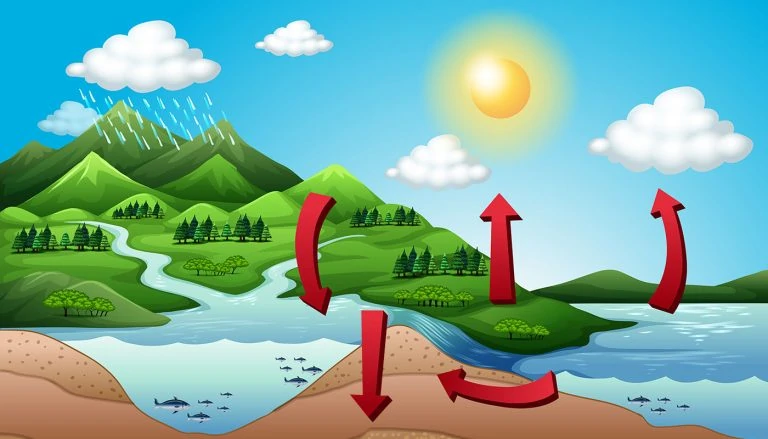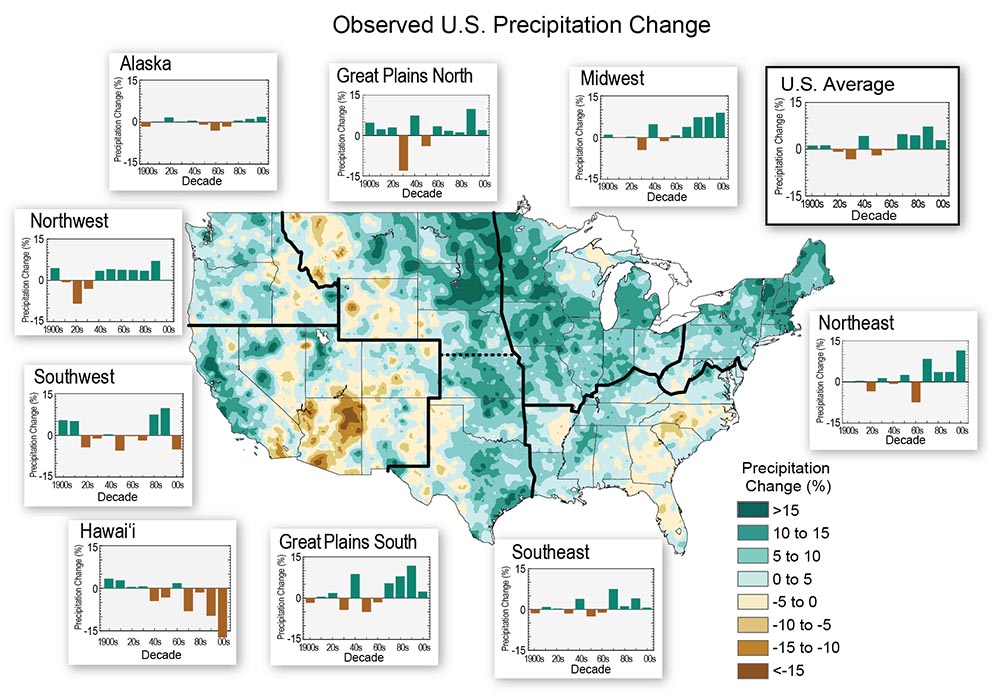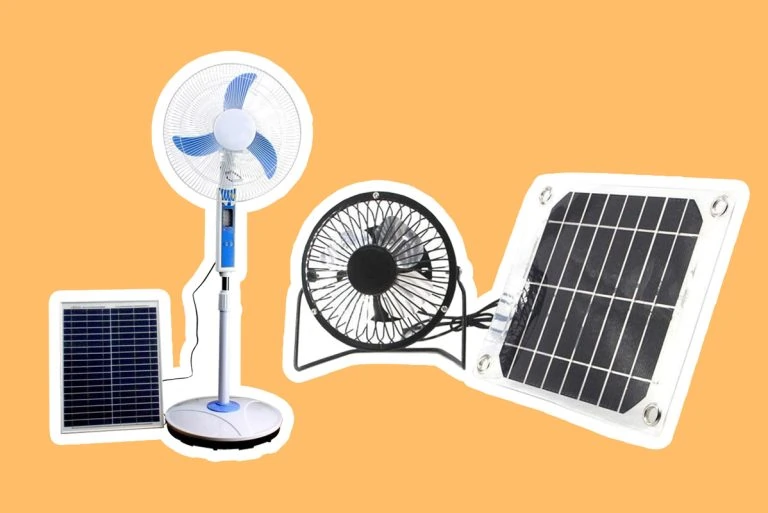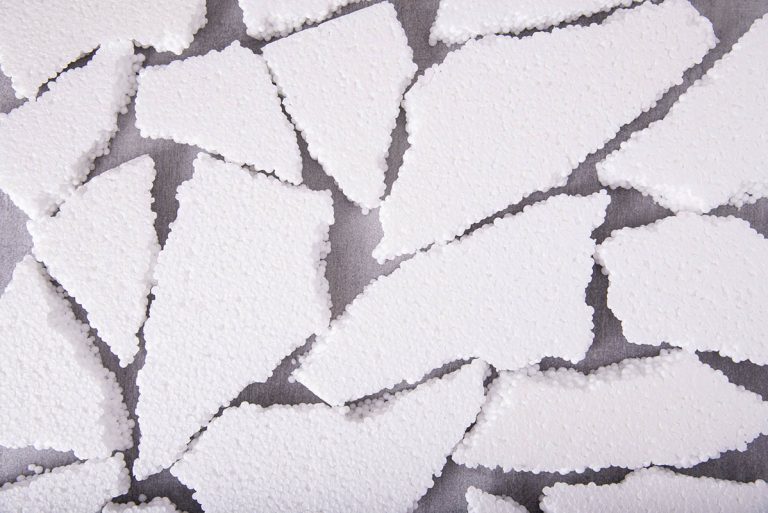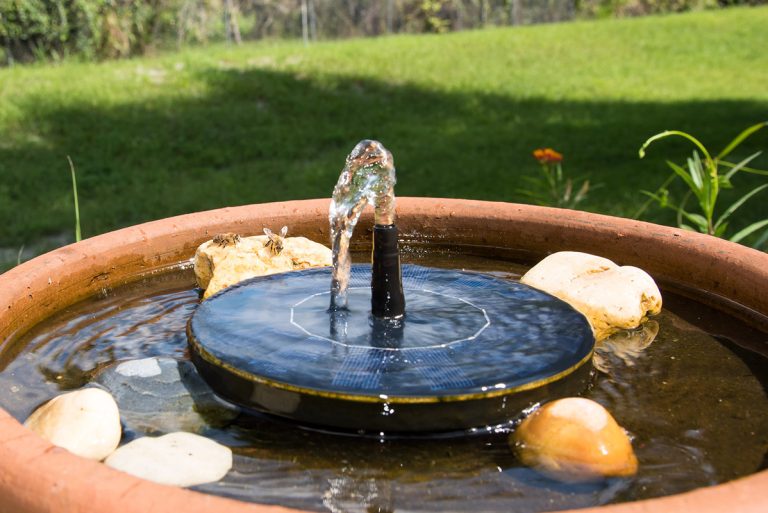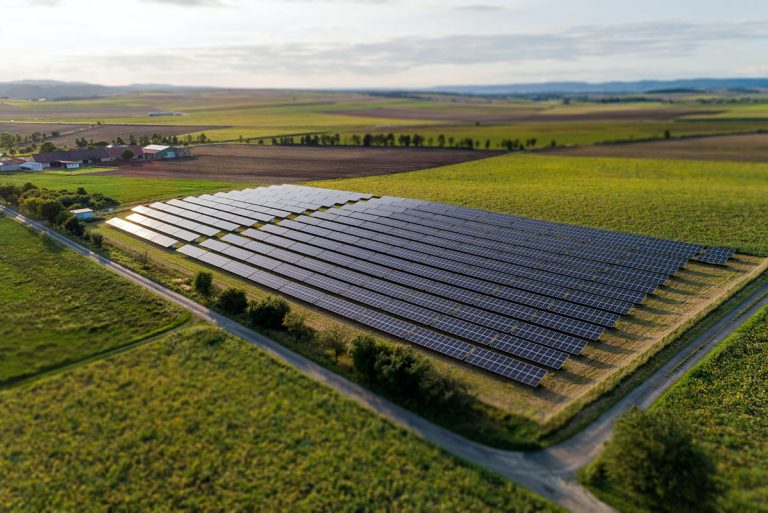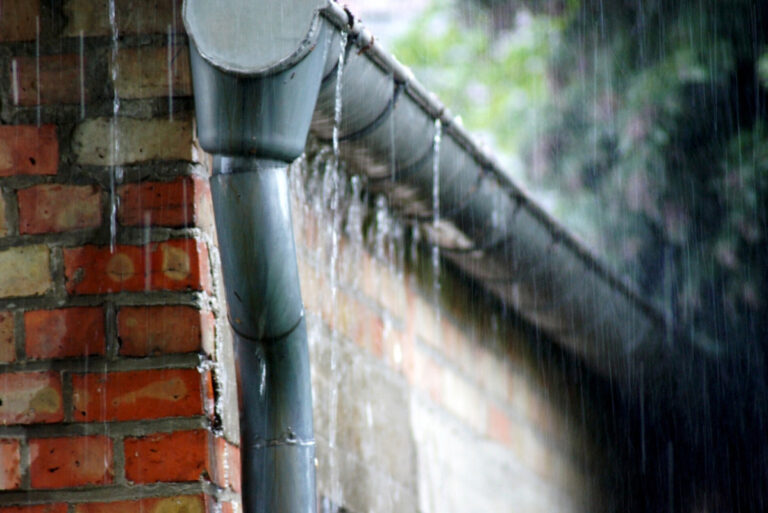Did you catch glimpses of the watery side of our climate crisis on the news in Summer 2021?
Here are some highlights in case you missed it:
- Sudden, heavy deluges of rain across several European countries, killing hundreds along with widespread destruction of property.
- Massive landslides due to torrential rainstorms in many countries including Japan, India, and the Philippines, leaving hundreds dead amidst devastation of entire towns and villages.
- Colossal flooding in China, drowning a dozen people trapped in subways and evacuating thousands more.
At the same time as certain parts of the world were inundated with water in 2021, other countries — like the western United States and Canada — as well as Brazil and Kenya among many other places — experienced the exact opposite: extreme absence of water (drought).
Along with the aridity came sky-high temperatures leading to novel weather phenomena: heat domes and atmospheric rivers.
The extremely wet or dry weather patterns of 2021 indicate that something has gone seriously wrong with the natural water cycle.
In this article, you’ll first learn about the natural water cycle.
Then, we’ll do a deep dive to discover the reasons why the water cycle is faltering so intensely all over the world.
You’ll also find out what you can do as a sustainable homeowner in your local community to “weather the storm” of water cycle breakdown before you get swept away.
Lastly, you’ll read about a few ways you can mitigate — on a larger scale — the intensifying effects of water cycle collapse during a climate crisis.
What is the water cycle?
In a stable climate system with little to no human interference, the natural water (hydrological) cycle works like the diagram below created by the National Oceanic and Atmospheric Administration (NOAA):
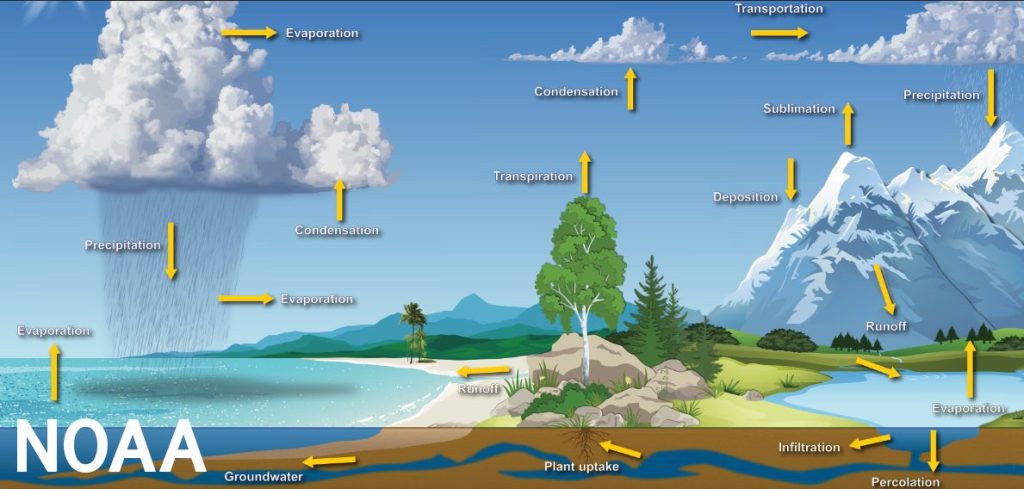
The first thing to note about this schematic is that there’s no beginning or end to water as a substance — nor to its motion.
In fact, the natural water cycle is a never-ending, global loop that traces the movement of a simple chemical substance made up of hydrogen and oxygen in a 2:1 ratio: H2O.
However, looks can be deceiving.
Water: the molecule of life
The “simple” water molecule possesses amazing physical and chemical properties that make life itself — as we know it — possible in the first place.
Part of its wonder lies in the fact that it can exist in three totally different states (phases) — solid, liquid, and gas (vapor) — over a relatively narrow range of temperatures in close proximity to each other somewhere in the land-sea-sky continuum that makes up earth’s planetary system.
How water travels in the water cycle
After remaining in the ocean for thousands of years, a single molecule of liquid water could eventually evaporate from the ocean’s surface, probably near the tropics where it’s warmer, and become gaseous water vapor in the atmosphere.
From there, it could travel for miles over many days before it reaches cooler temperatures at a higher altitude. Then the vapor condenses back to the liquid or solid (ice) state in a cloud.
When the cloud becomes saturated, rain or snow (solid water) will fall back to land or in a body of water.
And then the water cycle repeats itself.
Relative abundance of salt vs. freshwater on earth
Most (about 97%) of all the water associated with Earth is in the oceans (as saltwater). The remaining <3% is freshwater, mostly in the form of ice caps or glaciers.
Unbelievably, only a mere fraction of all water is freshwater that’s actually drinkable. Freshwater could be surface water (lakes, rivers, streams, and reservoirs), or groundwater (underneath the ground in aquifers).
Here is a helpful diagram that shows the relative percentages of water’s abundance on earth:
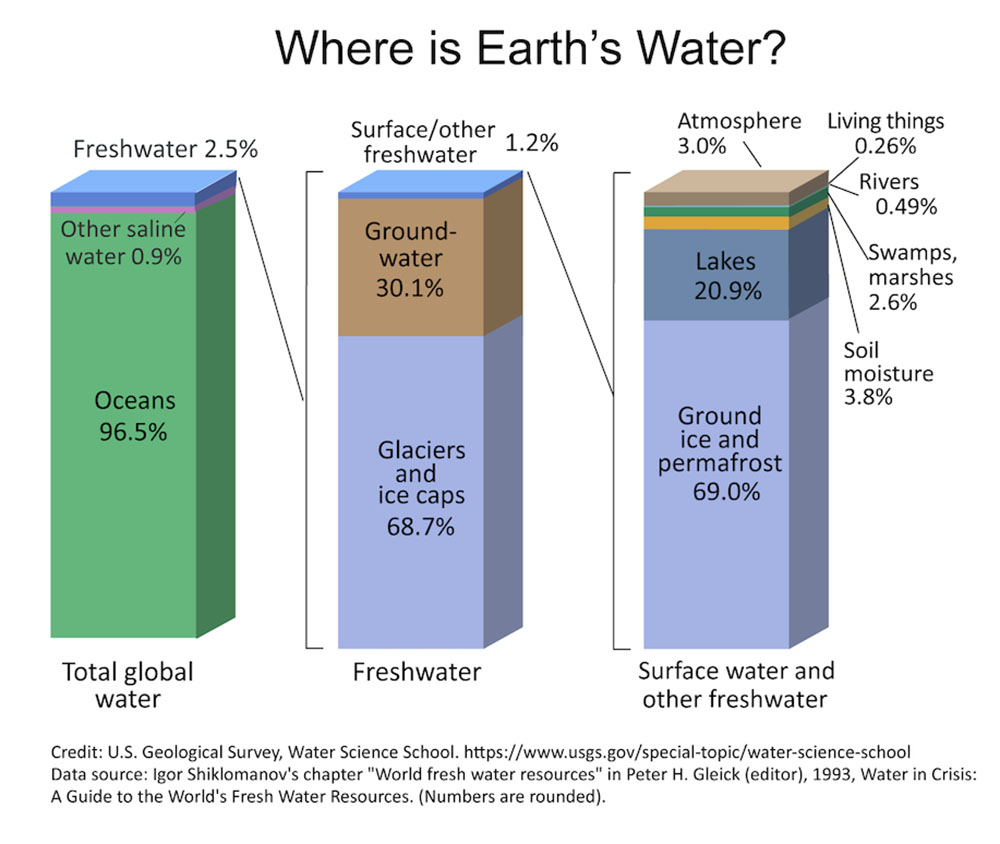
How does the water cycle help regulate climate?
The water cycle is inextricably involved in energy exchanges in the land-sea-sky system. The ultimate source of this energy is the sun.
Water absorbs and releases sun energy (radiation) in the form of heat. By making heat transfers around the world through its movements and phase changes, the water cycle regulates earth’s climate and determines how the climate will vary from place to place.
Importance of the ocean in the water cycle for climate stability
The ocean is earth’s largest heat sink, absorbing most of the sun’s energy that reaches earth, just like a sponge absorbs water.
At the same time, the ocean is the primary way water evaporates. Along with the water vapor goes energy in the form of heat. In this way, the ocean’s surface remains relatively cool while the atmosphere traps in some heat close to earth via its water vapor. (See next section.)
The ocean currents distribute the heat around the globe to maintain a sort of energy equilibrium (homeostasis) that’s required for climatic stability.

Source: Wikimedia (NASA / Ingwik)
Under normal circumstances, the currents move warmer water away from the earth’s center and toward the poles. In the process, the currents leave cooler water behind, essentially lowering the temperature of equatorial (tropical) waters that are more directly hit by the sun’s rays.
However, because of the high specific heat of water, the constant cycling of water keeps the average temperature in the surface waters relatively constant.
Importance of the atmosphere in the water cycle for climate stability
The United States Geological Survey (USGC) refers to earth’s atmosphere as a “superhighway in the sky” on which water moves in the form of vapor, carrying energy in the form of heat with it.
Compared to the huge quantities of water in the ocean and on/under land, there’s not much water in the atmosphere (up to 4% in humid areas but usually <1% in dry regions). And what’s there moves quickly by wind and air currents.
Water enters the atmosphere in the vapor phases in two ways:
- Most of it (90%) evaporates from the warm ocean’s surface.
- The rest of it transpires by plants/crops cooling themselves off.
The vapor rises in the atmosphere and stays there until it eventually reaches cooler air and becomes part of a cloud as liquid or ice. When the cloud becomes saturated, rain, snow, or sleet falls as precipitation back to the land or the ocean.
While in the atmosphere, water vapor and another component of air, carbon dioxide (CO2), serve a critical function of trapping some of the heat leaving the surface of earth.
In this way, water vapor acts like a security blanket, maintaining the global temperatures (surface and air) in a range suitable for life to exist.
Importance of the land in the water cycle for climate stability
Of the three major parts of the earth’s land-sea-sky system involved in the water cycle, the land is the least important in terms of energy (heat) transfers through water that determines climate stability.
Compared to the ocean, land quickly changes its temperature, either heating up or cooling down rapidly, because it doesn’t have a lot of energy to begin with (an effect of its lower heat capacity).
In other words, land can’t be a huge source or a sink of energy like the ocean is.
However, the land is important in the water cycle because it’s on the receiving end of freshwater precipitation that the soil needs as the substrate of all terrestrial ecosystems and life forms.
Also, the water table underneath the ground acts as a long-term storage vessel for freshwater.
Land masses at high altitudes (mountains) receive the freshwater precipitation in the form of a snowpack. Glaciers or ice caps may form, too.

Source: Wikimedia / Andreas Weith
Under normal circumstances, the natural water cycle provides a steady stream of freshwater from snowmelt for several months. This supplies potable water to millions of people at lower elevations as well as keeps aquatic ecosystems thriving.
Tragically, our climate crisis is upsetting this balance as glaciers and ice caps melt, putting millions of people in jeopardy.
Furthermore, without the white snow’s albedo effect, reflecting the sun’s rays, the dark land masses and ice-free oceans absorb more heat, further accelerating the melting of more snow and sea ice.
What does the IPCC say about the effect of climate change on the water cycle?
The Intergovernmental Panel on Climate Change (IPCC) released its sixth report in August 2021. Its major conclusion is that our climate crisis is “intensifying” the natural water cycle.
Here are some of the alarming points from the Sixth Assessment Report:
- There is no doubt that human activity has heated the atmosphere, ocean, and land (the sky-sea-land nexus of the water cycle).
- More global heating will further intensify the global water cycle, leading to severe flooding and landslides, heavier monsoons, extreme drought, and other catastrophic weather events worldwide.
- Many physical changes due to human-caused carbon emissions are irreversible for centuries to millennia, especially changes in the ocean, ice sheets, and global sea level.
How do human-caused greenhouse gases affect the water cycle?
Global heating created by the long-term presence of anthropogenic greenhouse gases (GHG) in the atmosphere directly affects the water cycle.
Under normal circumstances, water vapor and low levels of carbon dioxide (a measly 0.04% of air) naturally present hold in just enough heat to make life on earth possible. Without them, it would be too cold for living beings — as we know them — to thrive.
What are anthropogenic greenhouse gases?
Human-caused greenhouse gases hold in a lot more heat than we need to survive comfortably on earth, preventing this radiant energy from escaping into outer space.
Carbon dioxide, (CO2), a major source of carbon emissions generated from fossil fuel burning, is an example of a greenhouse gas.
Besides CO2, there are other gases that retain heat for long periods — decades or more — and contribute significantly to global heating.
Greenhouse gases that contribute to global warming:
- Carbon dioxide (CO2)
- Methane (CH2)
- Nitrous oxide (N2O)
- Hydrofluorocarbons (HFCs)
- Perfluorocarbons (PFCs)
- Sulfur hexafluoride (SF6)
- Nitrogen trifluoride (NF3)
Fluorine-containing chemicals from this list (the last four) are potent GHGs widely used in the electronics industry, refrigeration, and air conditioning.
There has been some commitment on the parts of many countries to phase out some of these chemicals because they accelerate our climate crisis so much. Finding safer alternatives has been difficult, however.
Ground-level ozone in the troposphere (close to earth) is another GHG common in urban smog. It is very harmful to human health.
However, ozone is usually not listed as a GHG because of its protective effect from harmful ultraviolet sunlight when it’s high in the stratosphere.
Water vapor as a greenhouse gas
Besides the water vapor naturally present in the air through evaporation, there is 7% more moisture retained by the anthropogenic greenhouse gases for each 1℃ (1.8℉) rise in temperature according to the Clausius-Clapeyron equation.
So far in human history, fossil fuel burning and deforestation (anthropogenic causes) have raised the global temperature about 1.1℃ above pre-industrial levels. Many climate scientists assert that 1.5℃ — the value frequently cited by the IPCC and others as the highest livable temperature for life as we now know it on earth — is already locked in for the 2030s because of past and present carbon emissions.
Let that sink in.
In only about ten years from now, 1.5℃ would spell severe climate breakdown.
Unfortunately, as the pace of oil and gas drilling accelerates in the 2020s, some market analysts and scientists predict a rise to 2℃ by 2050.
Logically, more moisture in the atmosphere translates into more heat energy retention leading to frequent and heavier rainfall and other extreme weather events including hurricanes.
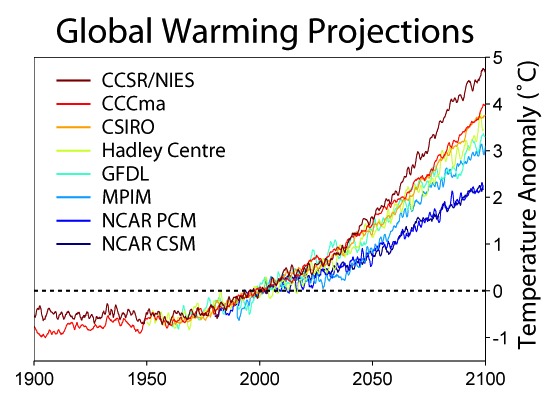
Source: Wikimedia / Robert A. Rohde
How does our climate crisis affect the different stages of the water cycle?
In many ways, our climate crisis is both the cause and the effect of perturbations to the water cycle. So, it’s easy to understand that every major process in the water cycle is affected somehow by our climate crisis.
Here are just a few examples of the far-reaching adverse impacts of our climate crisis on certain stages of the natural water cycle.
Evaporation
Since warmer air can hold more moisture than drier air, (see previous section), it will withdraw more water from the ocean and other water bodies. Similarly, it will pull out moisture from the soil, leaving it dry.
Both of these effects will adversely impact agriculture, terrestrial ecosystems, and drinking water supplies.
The added humidity will make even normally temperate areas seem like the tropics. They will be a breeding ground for insects, including disease-carrying mosquitoes.
Unfortunately, the added wetness to the atmosphere will reduce or even eliminate the cooling effect of human sweat, making it increasingly difficult to get relief in a heating world. Outside workers will suffer the most.
Precipitation
Eventually, the build up of moisture in the atmosphere must come crashing down according to the laws of physics in the form of rain or snow.
So expect more heavy downpours and blizzards, even in areas that aren’t used to receiving them. Conversely, regions that typically enjoy moderate rainfall may become desert-like and, thus, prone to wildfires.
More hurricanes and tornadoes, too, are expected in unlikely places and at unusual times, like Kentucky recently experienced in December 2021.
Here’s a peek at what to expect across the United States when viewing recent trends:
Surface runoff
Heavy rainfall landing in a short amount of time can cause streams, rivers, and lakes to overflow — leading to massive flooding of towns or farms. This is true especially in extremely dry areas where the soil can’t quickly take in huge amounts of water.
Instead, water just bounces off the baked ground.
In urban areas where there is very limited soil to absorb the water, there may be more flooding. Sewer systems will easily become overwhelmed, carrying trash, human and animal waste, pesticide runoff from farms, topsoil, etc., out to sea. There, the mess will wreak havoc on marine life.
Oceans
As discussed previously in this article, oceans are vitally important in maintaining climate stability. Their central place in the water cycle only makes their disruption to the global equilibrium (in terms of energy transfer and the water cycle itself) more adverse for all life on earth.
First, the ability of oceans as the major heat sink for earth (i.e., absorbing heat as it streams through the atmosphere from the sun), will be significantly reduced. As oceans reach their own heat saturation point, they will no longer be able to provide this service to humanity.
Consequently, the heat will impinge on land or remain in the atmosphere, heating up global temperatures even more.
Secondly, increasing carbon emissions enter the oceans, thereby acidifying it. Acidic water eats through the exoskeletons of marine organisms at the center of many food webs, or prevents them from forming in the first place.
Lastly, warmer waters have several severe consequences for the ocean and all life forms — both aquatic and terrestrial.
When oceans become too warm, they:
- Can’t hold as much dissolved oxygen for organisms whose home is the surface waters, so dead zones form.
- Chase many fish species seeking cooler waters to the poles, disrupting marine ecosystems.
- Weaken or alter major ocean circulation patterns that could lead to significant changes in weather all over the world. Recently, scientists announced observations of early warning signals of the collapse of the Atlantic Meridional Overturning Circulation (AMOC), one of the ocean’s major currents.
How can I prepare for weather extremes related to the water cycle?
If you currently live in a high-risk area for flooding or wildfires — which could be urban or suburban settings like Boulder, Colorado encountered in January 2022 — consider moving to a region where the risk is not too high now, nor predicted to become great later on. This may be the most sustainable thing you could do.
To inform your decision about whether to move or not, be sure to consider market forecasts on how insurable your home will be in the near and distant future. Tragically, many homeowners are experiencing huge premium rate hikes — or even losing coverage completely — because they live in areas at risk for flooding, wildfire, or other climate crisis-driven extreme weather.
Suburban and rural areas
However, if you don’t want to move or cannot relocate, become active on your community level and defend a sustainable lifestyle even in — or especially because of — a climate crisis. Put planning for how to protect your home when disaster strikes on your local government’s agenda by attending meetings and voicing your concerns.
You may even decide to run for office to become a decision-maker.
Since city or county ordinances are often necessary to build better homes that are capable of withstanding flames or floods, you can work to update the regulatory codes.
In fact, before you start investigating how to reinforce your existing home or build a fortified one, find out if you can legally do so in your district. If you can’t, move where you have this freedom, or get on the councils to update the standards.
To start your research, the Federal Emergency Management Agency (FEMA) overview of retrofitting methods is helpful if you’re dealing with potential flooding in a home you don’t wish to leave.
On the opposite extreme, CalFire is a wonderful resource for people in wildfire-prone regions who wish to harden their homes against flames.
Urban areas
There are a host of issues to consider when you’re thinking about how to flood-proof or fire-proof your city home.
Since most cities are paved, there’s little or no soil to absorb flash flooding. Greening the city — especially by removing parking lots or abandoned buildings to make space for parks — is one way to make it more permeable, as the short video below explains.
Just like your suburban and rural counterparts, getting involved in local politics will enable you to make necessary revisions to land use plans and building codes as a way to prepare for the floods or flames that our climate crisis is releasing all over the world.
Remember: No place on earth is immune to destruction when our climate crisis strikes. Prepare now to save yourself a costly cleanup, repair, rebuild, or relocation later.
What can people do to restore the water cycle during a climate crisis?
Ultimately, the only way to restore the natural water cycle is by removing excess greenhouse gases from the atmosphere and eliminating all fossil fuel burning. Whether humans can accomplish this fast enough to save civilization is an open question.
Political will is lacking, as the November 2021 Conference of the Parties (COP) demonstrated.
The approximately 100 fossil fuel companies responsible for 71% of global carbon emissions lobbied for continued exploration, drilling, and burning without a serious commitment to transitioning to renewables and keeping fossil fuels in the ground.
Because IPCC best- and worst-case scenarios rely on the nascent, experimental technology known as carbon capture and storage (CCS) for its projections although CCS lacks proven scalability, people are being misled by false hope. Worse, a large CCS plant run by Shell actually emits more carbon emissions than it takes in!
People are not being informed of the serious climate emergency confronting humanity and the need for drastic, immediate emissions reductions when they are led to believe CCS will save us.
According to many climate scientists and organizations including the Center for International Environmental Law, calling CCS in a July 2021 report “…“ineffective, uneconomic, and unsafe,” humanity must transition to renewable energy sources, stop wasting so much energy — United States lead with 58%! — and use energy efficient appliances. If they still own cars, electric vehicles are better than fossil cars.
Above all, the leading fossil fuel corporations must stop burning fossil fuels.
To remove the massive amounts of carbon dioxide already in the atmosphere will take trillions of dollars and should happen right now to prevent climate catastrophe. This level of investment and interest does not yet exist. Political activism and people’s protests are needed to change the status quo to address our climate crisis.
What can people do to reduce their water footprints during a climate crisis?
Fortunately, there are many things people can do to reduce their water footprints.
While it’s true that during a climate crisis some people will regularly receive too much water, even those individuals can make adjustments in daily living as a way to adapt to a changing water cycle and climate.
Of course, individuals living in drought areas must conserve every drop.
Direct and indirect water use
Everyone can become conscious of how they use water — both directly and indirectly — and take steps to conserve it.
Analyzing your water footprints is one way to begin.
Diet and water footprints
You may discover that becoming a vegetarian or vegan will allow you to conserve tens of thousands of gallons of water every year.
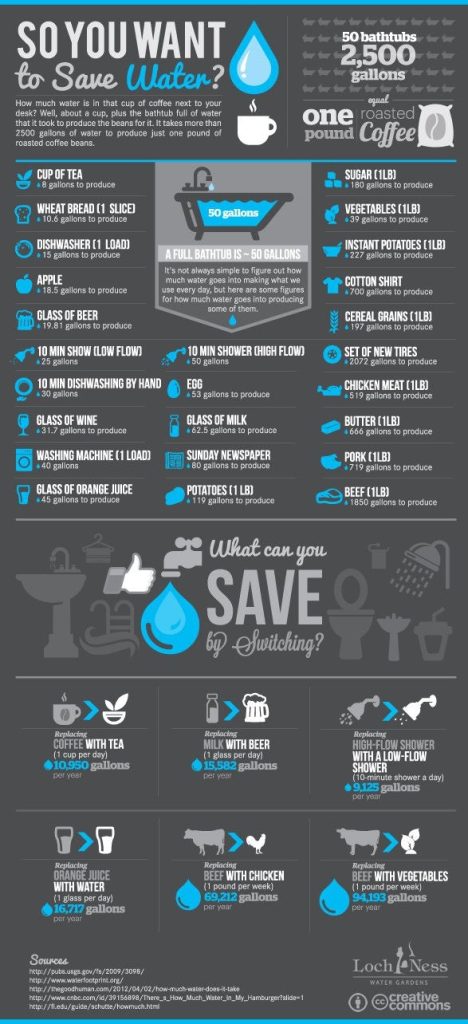
No matter where you live, growing your own food makes good economic and ecological sense as a way to reduce water footprints of food. This is also a good idea as crops fail worldwide due to our climate crisis, increasing food prices.
As long as people continue to burn fossil fuels, our climate crisis will only intensify. More crops will fail in more places — and more often. Expect high prices at the grocery store — if you can find what you’re looking for.
Energy use and water footprints
Likewise, switching to renewable energy instead of relying on coal or fracked gas from a power plant can save you from depending on billions of gallons of water per year for energy.
Here’s an infographic that illustrates this point.
Sustainability tips for people where water is plentiful
If you wish to live sustainably in an area with an abundance of water, you may wish to harvest rainwater for certain indoor uses as well as for lawn and garden purposes.
After filtering it, the water would be appropriate for cleaning at least.
Boiling it would make it potable. Read our post to learn more about the benefits of harvesting rainwater.
Imagine never using your tap again!
If you dehumidify your indoor air, use the collected water for houseplants or hand washing delicate fabrics.
Sustainability tips for people where water is lacking
People living under drought conditions need to do everything possible to conserve water. This is the case for thousands of Californians whose wells are running dry in heavy agriculture areas.
Water levels are so low in some of the largest human-made reservoirs in the United States — like Lake Mead and Lake Powell — supplying millions of people with water and servicing millions of acres of farmland, that hydropower from Lake Powell is predicted to end next year (2023). Not from lack of need, but from lack of water to operate the turbines.

Source: Wikimedia / Bureau of Reclamation
Other countries, such as Chile, are experiencing the same water crisis.
What will happen next is anyone’s best guess at this point.
Tip: It’s prudent to prepare for a water crisis well before you find yourself in that situation.
So, if you live in a drought area and you haven’t already converted your lawn to a rock garden, do so now.
Drip irrigation will distribute water more efficiently to plants’ roots in your vegetable garden.
Fixing all water leaks in indoor plumbing is a no-brainer when water is in tight supply. A low-flow, high-efficiency toilet and showerhead are essential, too.
Or try a compost toilet that requires no water at all.
Check our guides to the best composting and low-flow toilets for detailed reviews of our top picks on the market.
Key takeaways on the water cycle
The natural water cycle is a primary way that the sun’s energy circulates in the sea-sky-land system, keeping earth’s climate stable on a global basis.
Anthropogenic fossil fuel burning and deforestation have significantly upset the climate balance through the rapid (on a geological timescale) addition of carbon dioxide and other greenhouse gases to the atmosphere.
The retained atmospheric heat will continue to exert its negative effects — in terms of causing extreme weather all over the world — for centuries.
Furthermore, the influx of carbon dioxide to the ocean through the water cycle raises the ocean’s acidity and decreases its oxygen level. Both of these effects destroy the fragile balance of marine ecosystems.
All of these greenhouse gas impacts could lead to disastrous consequences for food webs, both terrestrial and aquatic.
Eventually and unless fossil fuel burning and deforestation stop before 2050, there will be widespread food and water scarcity and extreme temperature rise. We are already witnessing a lot of this. Human civilization could end.
In this article, you’ll find a few suggestions on preparing for weather extremes precipitated by abnormalities in the water cycle caused by our climate crisis. They will help you navigate water-related catastrophes on individual and community levels.
There are also a number of steps outlined here that you can take to lessen your own water footprints. Most importantly, though, is taking action on a political level to change energy practices and policy on national and international levels.
Time is of the essence if humanity wishes to restore the natural water cycle and climate stability to what they once were before fossil fuel burning accelerated beginning in the Industrial Age and continuing in full force today.
